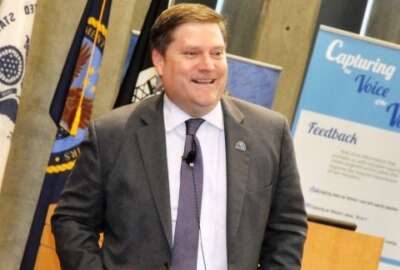Best listening experience is on Chrome, Firefox or Safari. Subscribe to Federal Drive’s daily audio interviews on Apple Podcasts or PodcastOne.
Veterans have higher expectations now for more convenience, a better experience and easy-to-use technology. And that is changing the way the Veterans Affairs Department — and the military services — are approaching their health care missions in 2018.
“We’re trying to position VA to be ready to adapt to a world where customers have a lot higher expectations,” Charles Worthington, the department’s chief technology officer, said Thursday at ACT-IAC’s Health Innovation Day in Washington. “Our goal is really to make VA a system that veterans choose to use. We want to make it so good an experience that they choose to use VA.”
High expectations from the veteran community are prompting VA to release new technological capabilities, with a new initiative out seemingly every week.
“For the first time, we made it possible for veterans to use whichever account they already had from the VA to access information and tools from across the administrations,” Worthington said. “Specifically what this meant is that 4 million patient portal account holders … can now use that login credential to access benefits information for the first time.”
Veterans can also now use the same login information to schedule primary and mental health care appointments online.
The department also partnered with Google DeepMind to create algorithms to improve clinical outcomes. As the health-care industry generates more data, VA sees an opportunity to share its own information with other partners for research purposes.
The department de-personalized 700,000 medical health records, Worthington said. DeepMind will train against VA’s current algorithms, like one that predicts acute kidney injuries, for example, to see if it can improve them.
“This is a template of partnership the VA is looking to do more of,” Worthington said. “I’m calling this one out just because it’s new and exciting, but this is representative of the opportunities we see to use data that we have to further research in the field.”
VA’s Lighthouse Lab, which the department announced in March, lets private sector developers use the agency’s data to build mobile and web applications that will help veterans better manage their care.
Worthington got his start in the tech industry developing apps for concert-goers. He said he came to government and realized that app-developers like himself could use those same, relatively inexpensive tools to develop solutions to more serious challenges, such as VA health care.
“The government is behind the curve in improving how far you can get for very small investments,” he said. “This is an experiment that I think is going to help us see what we’re able to achieve for very low dollar amounts.”
The Lighthouse Lab is pointed toward health care data now, but Worthington said VA plans to take the same approach to other corners of the department.
Higher expectations are also creating challenges for the Navy, where 75 percent of current uniformed sailors were born after 1986, said Vice Adm. Forrest Faison, surgeon general and chief of the service’s Bureau of Medicine and Surgery.
“We’re changing how we train our corpsmen, docs and nurses,” he said in an interview for Federal Drive with Tom Temin. “We’re changing our readiness. We’re changing how we do medical business and support to be able support a very highly-deployed Navy and Marine Corps — and at the same time be able to deliver on high combat survival in any future scenario.”
As patients prize convenience over continuity, many are getting worse care for a higher cost, Faison said. Driving health care into the community will give patients better options at a lower cost, he added.
Faison sees his sailors as a resource. When Navy hospital corpsmen came home from combat in the past, they typically worked as nursing or administrative assistants.
“We’ve stopped doing that,” Faison said. “We now put those corpsmen in clinics in the community and allow those corpsmen to provide care to active-duty patients supported by a doc[tor] by tele-medicine. That allows us to integrate health care into people’s lives. It allows us to provide a great clinical experience for our corpsmen for the next deployment, and it allows us to help our patients choose us instead of a costly health care alternative.”
But Faison, who said he ultimately sees the health and well being of his sailors as his primary focus, also called for a broader discussion about the health care industry. The military can help drive that change, he said.
“It is now time to look at the system, to look at the opportunities that are there,” Faison said. “Focus on select populations first to get some quick wins and begin to bend some of those curves — and ultimately drive to a future that is emboldened by better health at lower costs with better outcomes and better efficiency.”
Copyright
© 2024 Federal News Network. All rights reserved. This website is not intended for users located within the European Economic Area.
